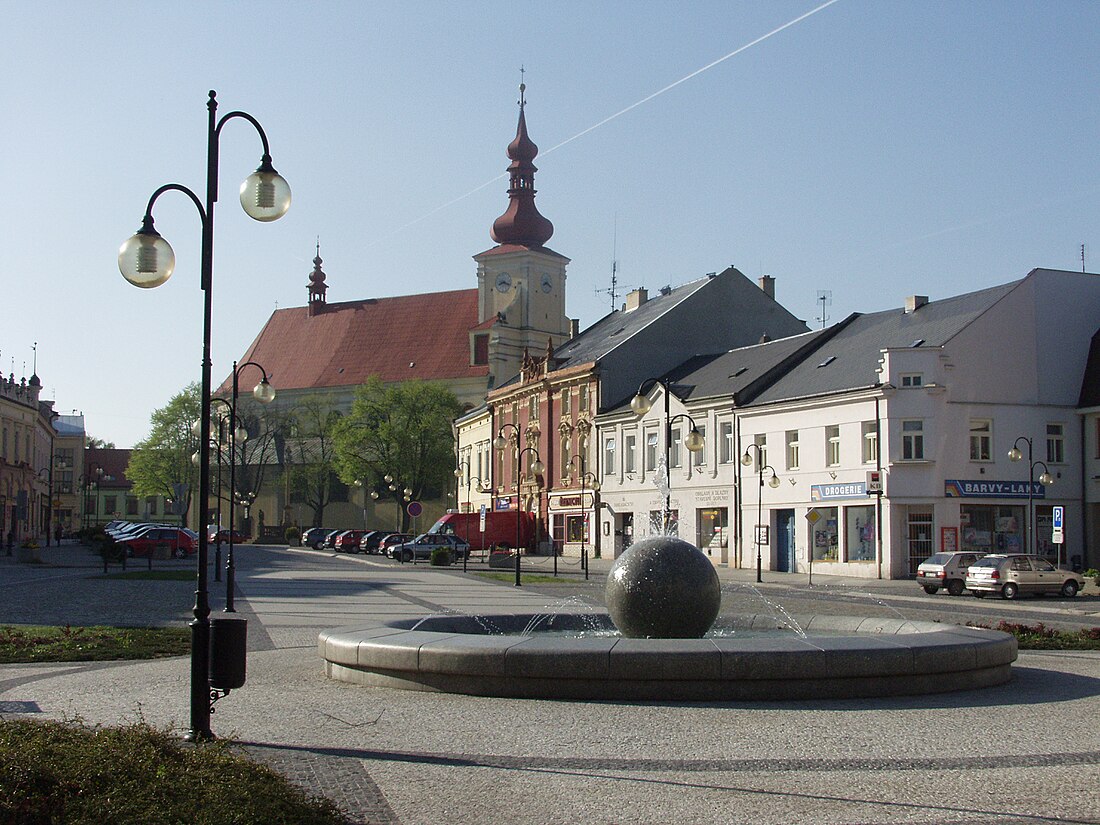Top Qs
Timeline
Chat
Perspective
Holešov
Town in Zlín, Czech Republic From Wikipedia, the free encyclopedia
Remove ads
Holešov (Czech pronunciation: [ˈɦolɛʃof]; German: Holleschau) is a town in Kroměříž District in the Zlín Region of the Czech Republic. It has about 12,000 inhabitants. The historic town centre with the castle complex is well preserved and is protected as an urban monument zone.
Remove ads
Administrative division
Holešov consists of six municipal parts (in brackets population according to the 2021 census):[2]
- Holešov (7,847)
- Dobrotice (438)
- Količín (344)
- Tučapy (406)
- Všetuly (1,998)
- Žopy (486)
Etymology
Geography
Summarize
Perspective
Holešov is located about 12 kilometres (7 mi) east of Kroměříž and 13 km (8 mi) north of Zlín. The Rusava Stream flows through the town.
The western and southern parts of the municipal territory with the town proper lie in a flat landscape of the Upper Morava Valley. The northern part with the villages of Dobrotice and Tučapy lies in the Moravian-Silesian Foothills. A small eastern part of the territory extends into the Hostýn-Vsetín Mountains and includes the highest point of Holešov, the hill Lysina with an elevation of 598 m (1,962 ft).
Climate
Holešov has a humid continental climate (Köppen: Dfb; Trewartha: Dcbo). The annual average temperature is 9.6 °C (49.3 °F). The annual precipitation is 627.5 millimetres (24.70 in). The extreme temperature throughout the year ranged from −29.9 °C (−21.8 °F) on 7 January 1985 to 36.9 °C (98.4 °F) on 1 August 2013.[4]
Remove ads
History
Summarize
Perspective

The first written mention of Holešov is from 1141 in a deed of Jindřich Zdík, when the settlement was a fief of bishops of Olomouc. Between 1300 and 1322, the market village transformed into a town.[9]
In the second half of the 14th century, Holešov was acquired by the lords of Sternberg. In the late 16th century, the town was held by Karel Sr. of Zierotin and later by Ladislav IV Popel of Lobkowicz. In 1574, the local Gothic fortress was rebuilt into a Renaissance residence. Holešov suffered during the Thirty Years' War and in 1643, the castle and two thirds of the town were burned down. From 1650 to 1762, Holešov was owned by the Rottal family. During their rule, the town was reconstructed, and a large castle with a Baroque French-style garden and the Church of Assumption of the Virgin Mary were built.[9][10]
The last owners of Holešov was the Vrbna family. After 1848, Holešov became the administrative centre of the Holešov District and the economic centre of the region. The town began to industrialize and the main industries were the woodworking, furniture, knitting and food industries. In 1960, the district of Holešov was dissolved.[9]
Jewish presence
The first mention of Jewish presence in the town is from 1391. The Jewish community began to form here after 1454, when the Jews were expelled from royal towns.[11] During the 17th century, Rabbi Shach served as a rabbi in Holešov until his death.[12] From 1849 until 1918, the Jewish community had its own administration separated from the town. In these times, the community participated on the town's industrialization and included successful entrepreneurs. The Jews almost disappeared from Holešov during World War II as the result of the Holocaust.[11]
The Old Synagogue was built after the local wooden synagogue was destroyed by a fire in 1560. The New Synagogue was built in 1893 and destroyed by the Nazis in 1941.[13][9]
Remove ads
Demographics
Economy
The public airport of regional importance in the southern part of Holešov was transformed into Strategic Industrial Zone, which is one of the largest industrial zones in the country.[16]
Transport
The short finished section of the D49 motorway connects Holešov with Hulín, where is the junction of the D1 and D55 motorways.
Holešov is located on the railway line Rožnov pod Radhoštěm–Kojetín.[17]
Sights
Summarize
Perspective


Holešov is known for its large castle with the French-style garden complex and a game park. The early Baroque castle was built in 1655–1674. Today the castle is open to the public and houses also the town museum and gallery.[10]
The landmark of the town square is the parish Church of Assumption of the Virgin Mary. The Baroque church was built in 1708 and consecrated in 1735. In 1748, the Black Chapel was added to the church. Under the chapel is the crypt of the Rottal and Vrbna noble families.[18]
Trinitarian monastery is a valuable Baroque complex of buildings, built in 1748–1750. Its Church of Saint Anne was originally a part of the pre-castle complex.[18]
The Old Synagogue is the second oldest synagogue in Moravia. It is an uncommon synagogue of the Polish type built in the Renaissance style which includes ornate ironwork and paintings on ceilings and walls using floral and animal motifs. The Old Synagogue, also known as the "Shakh" or "Šach" Synagogue, was preserved because it looked like an ordinary building from outside. Today it containts an exhibition about the life of Jews in Moravia.[13]
The Jewish cemetery contains about 3,000 graves. The oldest preserved tombstones are from 1647.[19]
Remove ads
Notable people
- Jan of Holešov (1366–1436), writer, linguist, musicologist and ethnographer
- Franz Xaver Richter (1709–1789), Austro-Moravian singer, violinist and composer
- Josef Drásal (1841–1886), the tallest Czech ever; lived and died here
- Mavro Frankfurter (1875–1942), Croatian rabbi
- Oldřich Vyhlídal (1921–1989), poet and translator
Twin towns – sister cities
 Desinić, Croatia
Desinić, Croatia Považská Bystrica, Slovakia
Považská Bystrica, Slovakia Pszczyna, Poland
Pszczyna, Poland Skawina, Poland
Skawina, Poland Topoľčianky, Slovakia
Topoľčianky, Slovakia Turčianske Teplice, Slovakia
Turčianske Teplice, Slovakia
References
External links
Wikiwand - on
Seamless Wikipedia browsing. On steroids.
Remove ads




